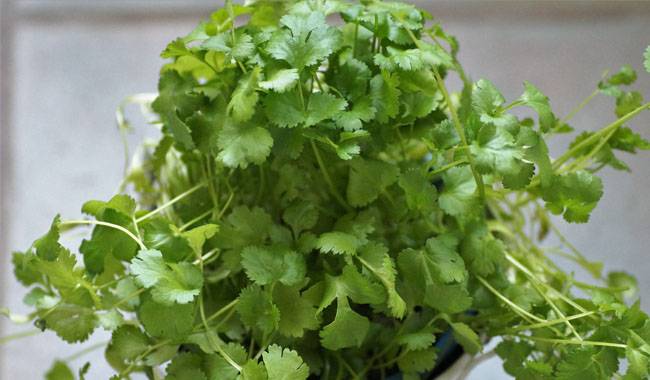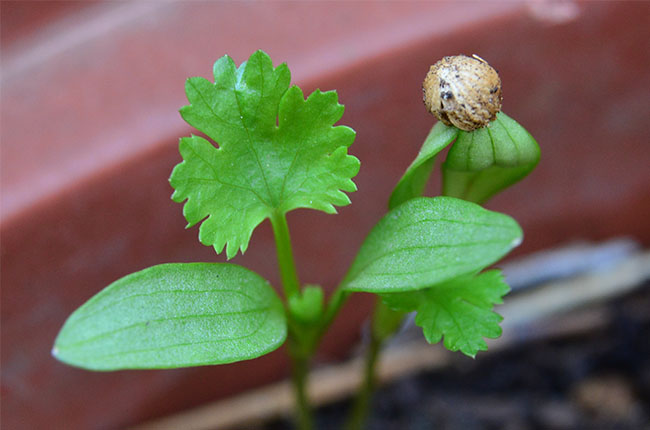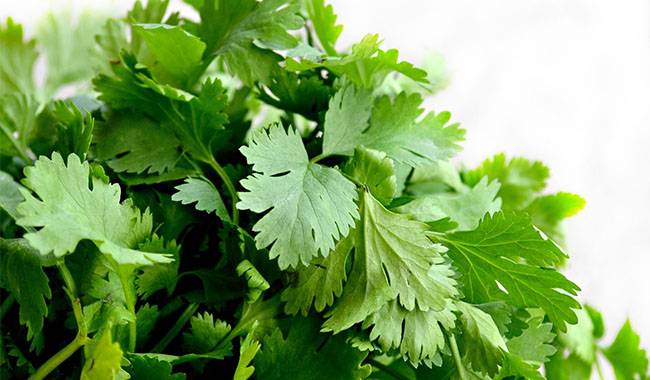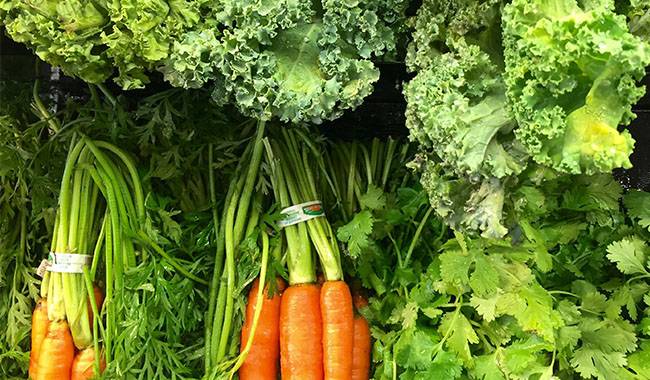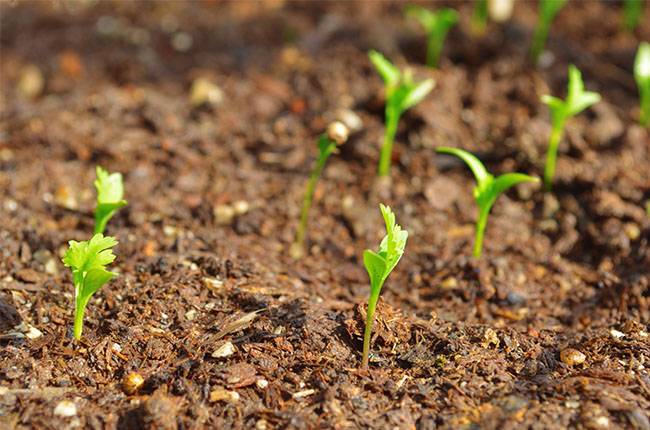
Cilantro has been on our tables for over 5000 years, it is an essential ingredient in soups, salads, pastries, meat dishes, and marinades, and its seeds are an independent spice.
How to grow cilantro? This article explains how to grow cilantro, how to care for it, and harvest and store it.
The Chinese used cilantro to enhance medicine and prolong life; Avicenna used it to treat stomach and heart pains; and in the Middle Ages, cilantro was used to make love potions. Let’s get to know this useful for longevity.
Cilantro is an annual herb with an original pungent flavor and aroma. In cooking, the herb and cilantro seeds (called coriander) are used as flavoring for a variety of dishes.
Cilantro does not require high growing conditions and does not need special care, so the spice can grow equally successfully in the open air on the windowsills of country houses and apartments.
INFORMATION ON CILANTRO
Cilantro (lat. Coriandrum sativum), or vegetable coriander, is an annual herb of the genus Cilantro in the Umbelliferae family, widely used as a spice in cooking and as a flavoring agent in perfumery, soap making, and cosmetics.
Cilantro sowing is a succulent plant. The name of this plant comes from ancient Greek, and one version comes from the word meaning “worm”: cilantro, when immature, smells like this crushed insect.
Another version has a homonym meaning “St. John’s wort,” so it’s hard to tell why cilantro is called parsley. For those who do not know until now, we inform you that cilantro and parsley are the same plants. Where it comes from is not known.
It is possible that it came from the Mediterranean. In any case, in Western and Central Europe, as well as in England, cilantro came from Rome and later from Europe to America, New Zealand, and Australia. Today cilantro is widely grown in Ukraine, the Caucasus, Crimea, and Central Asia.
PROPERTIES OF CILANTRO – BENEFITS, AND DISADVANTAGES
Benefits of cilantro
Cilantro leaves contain rutin, carotenoids, vitamins, trace elements and essential oils, and the fruits of the plant – steroidal compounds, tannins, sucrose, fructose, glucose, polyphenols, fatty oils, pectin, alkaloids, starch, and essential oils.
The useful properties of cilantro are enhanced by the seven organic acids it contains linoleic, oleic, oleic, ascorbic, myristic, stearic, and palmitic.
Due to its composition, cilantro has diuretic, anticarcinogenic, antipyretic, analgesic, and expectorant properties.
It disinfects the gastrointestinal tract, increases appetite, improves bowel movement, lowers blood pressure, helps cope with insomnia, relieves nervous tension and swelling, improves vision, increases efficacy, stimulates the kidneys, invigorates the spirit, and tones the body.
Cilantro juice strengthens gums, reduces bleeding gums, relieves toothache, and disinfects stomatitis.
The green vegetable brings harmful cholesterol out of the body, which is good for the cardiovascular system.
A few leaves of cilantro can reduce the effects of alcohol and eliminate hangovers.
Disadvantages of cilantro
Cilantro is contraindicated in diabetes, coronary heart disease, thrombosis, and thrombophlebitis, after a heart attack and stroke, during pregnancy, and breastfeeding.
Even perfectly healthy people can experience unpleasant consequences after excessive consumption of cilantro greens: disruption of sleep and menstrual cycle, memory loss.
Sometimes from excessive consumption of greens appear allergic reactions: itchy skin rash, abdominal pain, nausea, vomiting, stool disorders.
At the first signs of allergy, it is necessary to take antihistamines, otherwise, Quink’s edema and anaphylaxis can dramatically complicate the situation.
AGRICULTURAL TECHNOLOGY
Most of our compatriots learned this spicy herb through Korean cuisine. In the east, it has been cultivated for more than five thousand years.
Perhaps that is why it appears by another name – Chinese coriander. The Chinese attribute their immortal power to this spice.
Cilantro is a representative of annual herbaceous plants, characterized by early maturity and resistance to frost, but at the same time demanding in terms of soil composition.
On marginal lands, the crop grows weakly and moves quickly to the stalk, so it is best to start planting cilantro in early spring when there is a lot of moisture in the soil.
In February and March, cilantro can be planted in a greenhouse, and then the stalks can be placed somewhere on the 40th day after seed germination.
If sowing is done later, i.e. in May-June, expect to have flower stalks as early as day 20. Collect on time, immature seeds have an unpleasant odor.
When sowing, seeds should be 1-1.5cm (0.39-0.59inch) deep, the distance between plants should be about 9-13cm (3.54-5.11inch), and the distance between rows should be 28-33cm (11-12.9inch), so that when cilantro shoots germinate and begin to grow actively, they must be thinned to retain the specified distance.
Cilantro is an all-day plant, therefore, its growth will be slowed down due to lack of light. If cilantro is planned to be grown for greens, it must be removed as soon as the inflorescence begins to form, since the emergence of buds is not desired.
The leaves of cilantro are uneven along the stem. The lower ones have petioles and the top ones are located directly on the stem, the latter having a slightly longer shape. The flowers are collected in a small umbrella.
There are pink and white flowers. The main stem of the cilantro ends with a central umbrella and starts flowering from there. The other umbrellas open at the same time when they are opened.
The leaves are best harvested when the cilantro is at the rose knot stage about 15-20cm (5.9-7.87inch) high. After cutting, it is recommended to feed the plants.
Caring for cilantro is not difficult at all: weeding and watering every 8-10 days. It is recommended to water during dry times and if the humidity is sufficient, there is no need to water the cilantro.
EXPERT ADVICE
Cilantro in the garden requires a lot of light. As mentioned above, shade or shaded positions can delay its maturation.
At the same time, the yield decreases sharply and the content of essential oils is considerably reduced. Therefore, to obtain seeds, it is necessary to sow them in open areas.
Cilantro also requires moisture. The most moisture-sensitive periods are the beginning of the stem and the time of flowering. Therefore, to obtain seeds, water them promptly or cover the soil tightly around the bush.
High temperatures can disturb the ovaries – above 35°C (95°F), barren flowers will appear and the smell of grass and fruit will change considerably.
Therefore, it is better to sow parsley from March to May rather than in the summer. Resume sowing from late August to early October.
Cilantro works well on fertile soil, black calcium soil. For good growth, she prefers soils with a near-neutral reaction.
GROWING CONDITIONS
The plant prefers sunny areas. In the shade, it grows slowly and does not collect the essential oils that give it its flavor and aroma.
Without them, cilantro is a common weed. It prefers neutral or slightly acidic soil.
It grows on different types of soil but grows better – on loose, fertile soil without low-lying standing water. Where it is too wet, its roots rot.
Cilantro grows well with other herbs, such as cumin or fennel. The plant’s best predecessor is perennial grass.
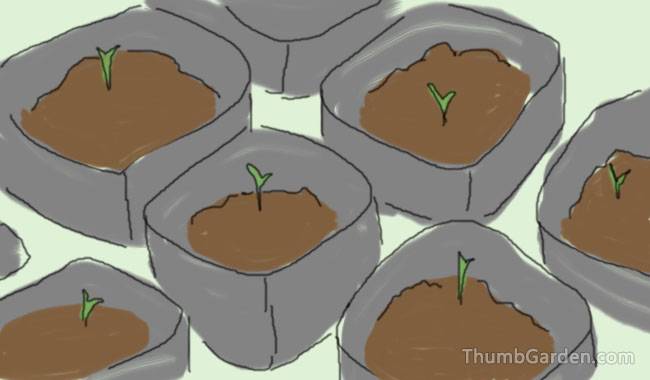
SPRING CYCLE
In April, when the soil is dry, the seeds can be sown by scattering them directly on the plot in the desired area and incorporating them with a rake.
Seed consumption is 2 grams per 1 square meter. The disadvantage of this method – it is almost guaranteed that the sprouts are not flush – where it is dense, it is empty.
The hoe angle or flat trenching, which is slightly more difficult but more technologically advanced, is done at a depth of 1-2 cm (0.39-0.78inch) with a distance of 10-15 cm (3.93-5.9inch) between the furrows.
Seeds were sown one by one at a distance of 3-5cm (1.18-1.96inch). Carefully fill the furrow with soil using the inverted tip of a hoe, plowshare, or harrow.
In warm, moist soil, seeds will germinate in 10-15 days, even without soaking and in cold soil in 14-21 days. Soaking the seeds in warm water for a day or two will result in faster germination.
Green leaves will appear 30-45 days after germination, depending on weather conditions. The bush can be cut when it reaches a height of 20-22cm (7.87-8.66inch).
Do not miss the flowering stage of the plant, because when the cilantro puts out its flower stalks, the leaves quickly become rough and will be inedible within a week, losing their marketable appearance.
By this time cilantro has been harvested for storage. Either they are dried like other greens or put in the freezer.
To prolong the growth period of the so-called fresh herbs, the flowers should be cut off and cilantro should be watered more often (if the rains are bad or not), dry land will speed up the growth of the flower stems and shorten the harvest period of fresh herbs.
But remember that this plant does not like to be watered too much. The norm for watering is 5 to 8 liters per 1 square meter.
In order to have marketable greens throughout the summer, cilantro should be planted several times, at intervals of 2 to 4 weeks.
If you plant cilantro for the first time, it can be more convenient later. Leave a few flowering stems on the plot, more or less evenly distributed throughout the area. In autumn, the plants drop their mature seeds.
By spring, they will germinate on their own, without your involvement. And, in general, much earlier, because sowing seeds in the mud in early spring is not always the right time to do so.
And winter cilantro will decide on its own when to germinate and then grow on its own, almost as if it were in the wild.
SUMMER CYCLE
Everything is the same as in spring, the only difference is the timing. The summer cycle is much faster because the weather is much warmer, the ground warms up sufficiently to a greater depth, and the daylight hours are longer.
In summer in moist soil cilantro germinates in 6-8 days without soaking, soaked seeds germinate faster. Marketable greens will appear 20-25 days after germination.
In addition, the moisture content of the soil varies during the summer months. In spring there are still moisture reserves from the snowmelt, there is no heat yet, and the soil does not dry out as quickly.
In summer with hot sunshine, the ground dries out in a few days, so the moisture content of the soil must be watched more carefully than in spring, especially during the emergence period.
In dry soil, seeds may not germinate and germinated seedlings may wilt up because the root system is still too small to get water from deep down.
HOW TO GROW CILANTRO
Soil
It is best to grow cilantro in a light, sandy loam, loamy soil. She prefers shaded areas, so it is recommended to lay the beds under fruit trees with a crown spread.
During the preparation of the beds, introduce about 3 kg of hummus or mature compost per square meter of soil into the soil. The best precursors for cilantro are legumes and grains.
For growing fragrant green plants in the apartment in winter, both purchased substrates and soil from the garden are suitable.
Often these two types of soil are combined and the result is fertile soil for plants.
You can buy ready-made soil in gardening stores. Universal for all types of plants. In addition, you can prepare nutritious soil with your own hands.
The required list: humus; sand; turf land; ash.
The soil in summer farmhouses can cover the larvae of pests. Before sowing, the ground is sifted and calcined in the oven. The addition of wood ash helps to purify the soil.
Sowing seeds
In winter, only seeds are allowed to grow parsley on the windowsill. Moreover, their germination decreases after 2 years. In order to get a green harvest all year round, it is better to sow seeds at different times, at intervals of 21-30 days. The sowing process should begin with the initial preparation of cilantro seeds.
Steps.
- Pre-soak the seeds in warm water for 2-4 hours. It is necessary to swell the shell and increase the chances of germination.
- In loose soil, form grooves up to 2 cm (0.78inch) long and 5-6 cm (1.96-2.36inch) apart.
- Using a syringe, carefully spread the seeds with a layer of loose soil.
- For better germination, the container should be covered with a bag or film. Place in the warmest corner of the apartment.
Choose the end of April to sow the seeds. Cilantro is a hardy plant, but it takes a longer time to germinate because of the dense seed coat.
Before sowing, it is recommended to stratify cilantro to speed up germination (stratification – keeping seeds in cold conditions for a long time to speed up germination).
Dig the bed for sowing cilantro to a depth of 20 cm (7.87inch), level it, and water it. After a few hours, sow the seeds and plant them in rows 2cm (0.78inch) deep in moist soil.
Note: After the first sprouts appear, place the parsley on the windowsill. You can enjoy the first fresh leaves after 3 weeks.
Create the necessary conditions: air humidity, light, and temperature
Cilantro does not like the surrounding climate. However, when the most comfortable conditions are created, the plant will be delighted by the lush foliage and the pungent aroma.
Greens prefer a well-lit area of the house, so place seedling pots on a windowsill. In winter, when the days are short, additional lights need to be installed.
Due to the lack of light, the plants can stretch but are fragile at the same time. Without proper lighting, it is almost impossible to get lush green plants.
The daily standard for cilantro is 6-9 hours.
Cilantro can tolerate cold winter indoor temperatures. Even at 6-10°C (42.8-50°F), the plants will not die. However, you should not expect rapid growth of cilantro in these conditions.
Seedlings of lifeless rare leaves show painful signs of lack of heat. The optimal temperature in the room is considered to be 18-25 °С (64.4-77 °F).
Maintaining moisture is equally important for the proper development of stems and lettuce. Here there are no difficulties enough to maintain a balance between high humidity and dry air. For this purpose, the room should be systematically ventilated to ensure proper air circulation.
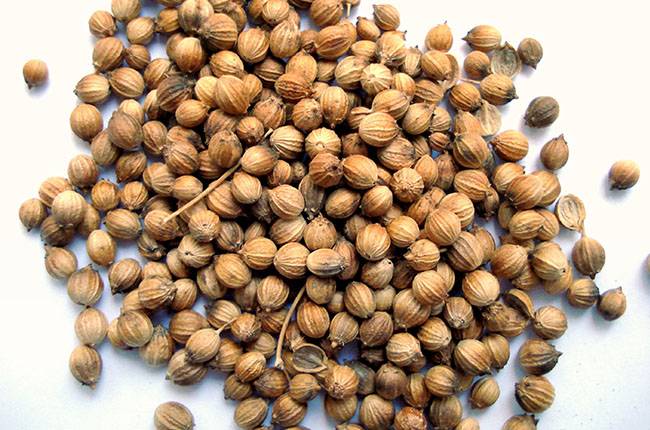
CARE: WATERING AND FEEDING
The culture has been planted and the first shoots have germinated. Plant care enters a critical phase. This includes thinning, feeding, and watering measures.
Cilantro likes to be watered heavily, but stagnant water in the pot is unacceptable. Too many soil rots and pathogens and molds can thrive in it. The root system will soon die.
How to water.
Water cilantro liberally, draining any remaining water from the pot.
You can get the green leaves with a spray bottle.
use water for irrigation at room temperature.
not to allow the soil to dry out.
increase watering during the active growth phase and decrease it during the winter.
Cilantro grows poorly in both overly dry soil and water-soaked substrates.
It is best to feed the plant after the first rose knot has formed when the sprouts become stronger. Cilantro prefers mineral supplements. Fertilize fruits and vegetables 2-4 times a month.
CARE OF CILANTRO
The care of cilantro is not troublesome, but it needs to be done correctly and regularly.
Under favorable conditions, germination begins to appear in the second week after the seeds are sown. During this period, all care usually consists of systematic watering only.
Watering should be done no more than twice a week, at a rate of (4-5 l/m2.) This amount is acceptable during the growing season when the plants acquire a green quality.
During the maturity period, watering should be reduced to 2 liters/1 m2. When the plant reaches a height of 2-3 cm (0.78-1.18inch), fruit thinning is required.
By pulling out unnecessary shoots, it should be ensured that only the strongest shoots remain on the bed and that the shoots are at least 6 cm (2.36inch) apart.
Further care of the plants includes hoeing and weed removal. Weeding and loosening can be done with tools if the plants are planted at normal distances, or by hand if they have to be sown in dispersion.
If the spices are planted on a windowsill or in a greenhouse, then care will only require regular watering and loosening of the soil.
HOW DO I HARVEST CILANTRO?
Harvest cilantro, like most pungent herbs, before flowering. The green color of the flowering shrubs is bitter and unfit for consumption.
To extend the harvesting period, the plants should be cut back periodically when their inflorescences begin to drop their leaves.
Cilantro leaves are at their spiciest when the plant has stopped growing, which means it is time for the final harvest, as flowering will start next.
During this time, the leaves are cut off for harvesting. It is best to cut the vegetables in the morning. For storage, it is recommended to make large bundles of cilantro and hang them in a dry, dark place to dry.
It is recommended to let the spices dry completely before shredding. Cilantro (seeds) are harvested in late summer. Collect them several times over a period of 1-2 weeks, as they ripen unevenly and break up as they mature.
Dried cilantro – the characteristic pungent aroma from the seeds indicates the maturity of this spice.
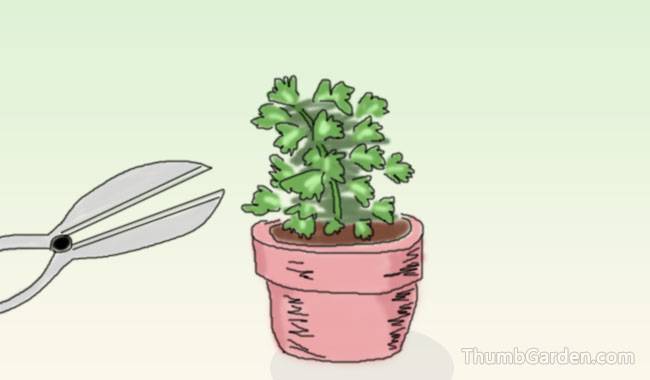
HOW TO STORE CILANTRO?
Fresh vegetables should be included in the daily human diet. Fresh greens are needed by the body to sustain life more than many other products.
Like cilantro and dill, parsley can be left in the refrigerator for longer periods of time without wilting.
To do this, pour a small amount of water into a plastic bag, container, or glass in which the greens will be placed, close, and move to the lower shelf of the refrigerator.




